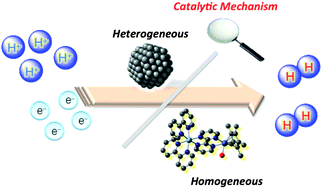Catalytic mechanisms of hydrogen evolution with homogeneous and heterogeneous catalysts
Abstract
This perspective focuses on reaction mechanisms of hydrogen (H2) evolution with homogeneous and heterogeneous

* Corresponding authors
a
Department of Material and Life Science, Division of Advanced Science and Biotechnology, Graduate School of Engineering, Osaka University, ALCA, Japan Science and Technology Agency (JST), Suita, Osaka, Japan
E-mail:
fukuzumi@chem.eng.osaka-u.ac.jp
Fax: +81-6-6879-7370
Tel: +81-6-6879-7368
b Department of Bioinspired Science, Ewha Womans University, Seoul, Korea
This perspective focuses on reaction mechanisms of hydrogen (H2) evolution with homogeneous and heterogeneous

 Please wait while we load your content...
Something went wrong. Try again?
Please wait while we load your content...
Something went wrong. Try again?
S. Fukuzumi, Y. Yamada, T. Suenobu, K. Ohkubo and H. Kotani, Energy Environ. Sci., 2011, 4, 2754 DOI: 10.1039/C1EE01551F
To request permission to reproduce material from this article, please go to the Copyright Clearance Center request page.
If you are an author contributing to an RSC publication, you do not need to request permission provided correct acknowledgement is given.
If you are the author of this article, you do not need to request permission to reproduce figures and diagrams provided correct acknowledgement is given. If you want to reproduce the whole article in a third-party publication (excluding your thesis/dissertation for which permission is not required) please go to the Copyright Clearance Center request page.
Read more about how to correctly acknowledge RSC content.
 Fetching data from CrossRef.
Fetching data from CrossRef.
This may take some time to load.
Loading related content
